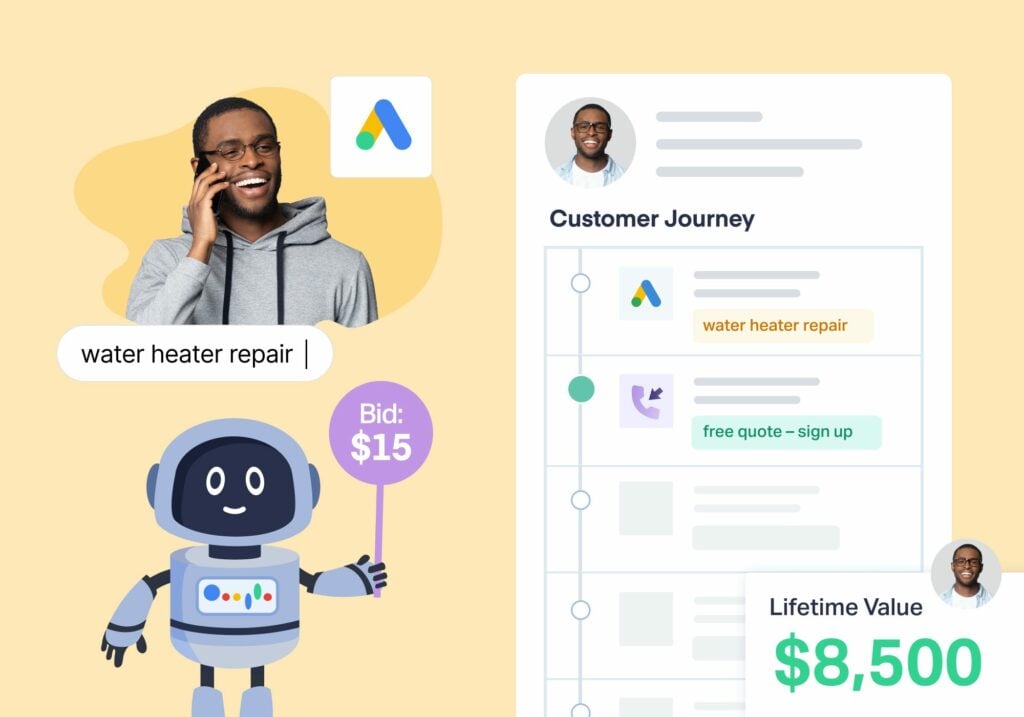
Quick quiz—if you had to choose, which lead would you bid more on:
- Lead A
- Lead B
Impossible choice, right?
You know nothing about them. And more to the point, you know nothing about the potential revenue each will bring in.
Now, what if we add an extra layer of data:
- Lead A: $8,000 value
- Lead B: $500 value
The choice just got easier—the answer is clearly Lead A.
That’s value based bidding in a nutshell. This bidding strategy lets PPC advertisers shift Google’s automated bidding away from quantity (maximize conversions, target CPA) and towards quality (maximize conversion value, target ROAS).
The problem is value based bidding can be problematic for lead gen agencies and marketers. But don’t worry—there are a few things you can do to make value based bidding more successful if you’re in the lead generation business. And that’s exactly what this guide covers.
How Does Value Based Bidding Work?
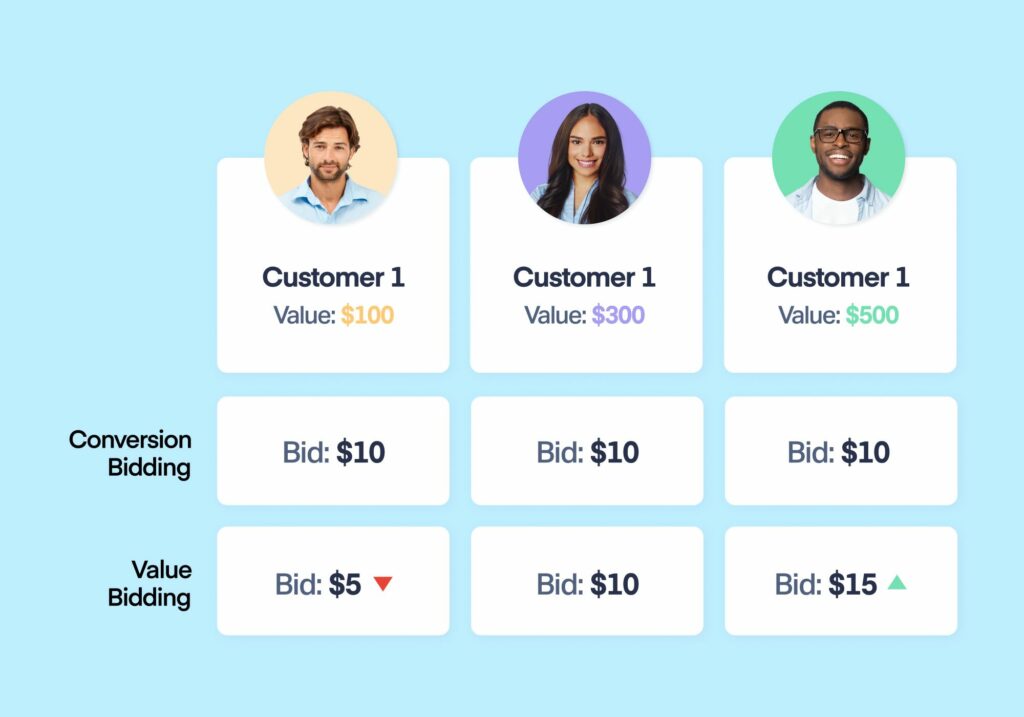
So what does value based bidding do? How does it actually work?
With value based bidding, you can assign unique values to different conversion actions. Google’s algorithm can then change its automated bidding strategy based on those values.
Think of it like adding weight to different conversions.
A newsletter signup may be worth a $5 bid. But the algorithm might be more likely to spend up to $15 on a trial signup—a higher value conversion action.
Value based bidding strategies come in two flavors:
- Maximize Conversion Value: Rather than attempting to generate the most conversions for a given budget (maximize conversions bidding strategy), maximize conversion value will target leads with a greater conversion value. That means it may bid higher for high-value conversions and lower for low-value ones.
- Target ROAS (tROAS): Basically a modification on maximize conversion value, this value based bidding strategy puts a return on ad spend (ROAS) cap on your bidding.
Are Value Based Bidding Strategies Effective?
Google seems to think so.
According to Think with Google, advertisers that switch their bid strategy from target CPA to target ROAS see conversion values increase by an average of 14%.
Its Smart Bidding Practitioner’s Guide also points out success stories with results like ROAS boost of 34% and conversion value increase of 80%.
Challenges of Value Based Bidding for Lead Generation Businesses
While value based bidding is great for industries where a conversion equals a sale (think ecommerce), it’s a bit tougher for businesses that rely on leads and offline conversions.
Home services, medical providers, law firms—prospects for these businesses usually don’t become customers after a single online visit.
And for the marketing agencies servicing these clients, value based bidding can be tricky.
Here’s why:
- Long Sales Cycle – Sales cycles for some businesses can last for months, even years. For the marketers running campaigns for those businesses, that’s way too long to wait to see what’s working and what isn’t.
- Customer Lifetime Value – One of the most common attribution problems stealing credit from marketing agencies, value based bidding doesn’t take into account customer lifetime value (unless you do a bit of work upfront—more on that later).
- Marketing/Sales Disconnect – Many marketing agencies don’t have access to the sales numbers they need to put an accurate value on conversion actions needed to make this bidding strategy effective.
So, how can you use value based bidding effectively, even if you’re a lead gen business or agency?
5 Optimization Strategies for Lead Gen Value Based Bidding
1. Calculate Values for Each Conversion Action
Since leads often follow a process of conversion actions before becoming a customer, you need to assign values to each in order to get the most from value based bidding.
This isn’t actually as hard as it seems.
In fact, Google actually offers a tool that does all the heavy lifting for you.
All you need to know is:
- The final sales value of a lead (could be dynamic based on service/product price or could be static based on an average order value or AOV of your entire customer base)
- The conversion actions they take on their customer journey
- The conversion rates between each conversion action
Then, just fill in the data and the tool will calculate the value of each conversion action for you.
For example, I took a hypothetical roofing client through the process below using dummy data. All in all, the process took under 1 minute. You can see the results below.
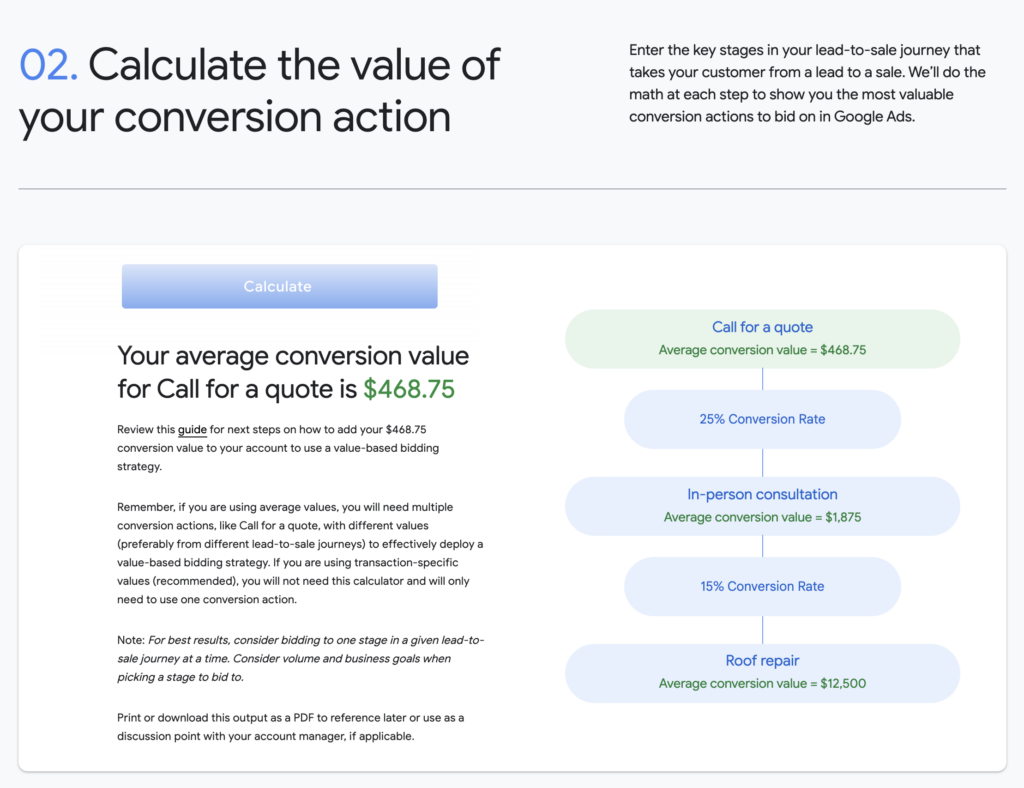
Then all that’s left is setting the values for each conversion action within your account according to the calculator results.
You can start using the tool at the link below.
2. Pass Back Data As Often As Possible (Automate for Best Results)
The more data Google has to work with, the better it will become at picking out leads with a high probability of being valuable for your clients.
In addition to sending Google Ads quality lead data, you should also aim to report conversions to Google on a daily basis.
You can do this manually or you can do it automatically—if you have the right tools.
For example, WhatConverts lets you automatically send lead data to your Google Ads account whenever the sales value is updated.
And with Lead Intelligence, you can fine-tune which leads you’re sending. This gives you even more control over what type of data you’re using to train the algorithm.
Automating your data transfer is especially valuable when your conversion values are dynamic rather than static. The more data on dynamic conversion values you send Google’s way, the better it’ll become at targeting leads that are higher-value and more likely to become customers.
Google outright recommends doing so in its guide to smart bidding strategies.
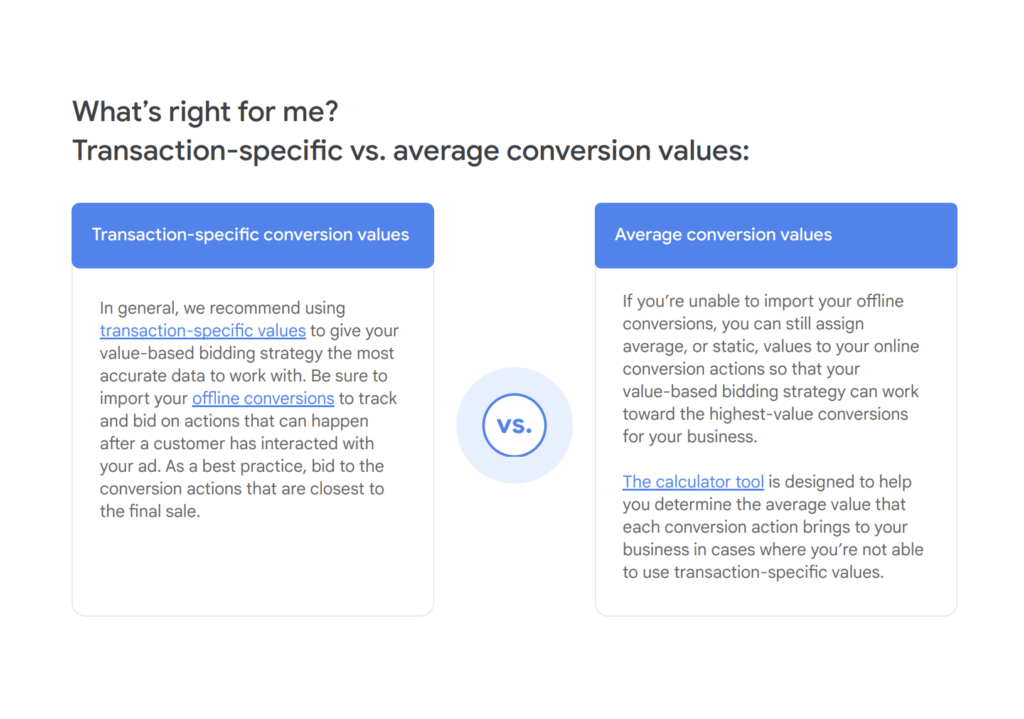
Lead tracking tools like WhatConverts often integrate with CRMs to automatically update transaction-specific conversion values.
You can read more about that approach (and other helpful best practices) in the guide below.
3. Use a Proxy for Sales Value If Necessary
While attaching final sales numbers to a lead is ideal, it’s data that isn’t always readily available.
For example, some clients don’t willingly share individual sales numbers with their marketing agencies (the marketing/sales disconnect).
Others have especially long sales cycles that make it impossible to train the algorithm effectively (offline conversions uploaded more than 90 days after the associated click won’t count in Google Ads).
So, what’s a marketing agency to do in this situation?
Use a sales value proxy.
Quote value works just fine here.
If you have conversion rates from your client’s sales team, you can fine-tune things even more. For instance, you could calculate this by multiplying quote value—$8,000—by the conversion rate—35%—to get a proxy sales value of $2,800.
You can even set Lead Intelligence rules in WhatConverts to do so automatically.
Note: Consider CPC When Using Custom Conversion Values
The benefit of value based bidding comes from showing the value of leads 1) relative to eachother and 2) relative to the cost-per-click.
For example, a 1-10 point scale for conversion values is fine with a CPC of $1-$2. But if you’re working with $100 CPC, a conversion value of $10 is going to look like a massive loss to your clients.
Instead, scale up your point system based on the average industry CPC if you’re using custom values.
4. Take Into Account Lifetime Customer Value
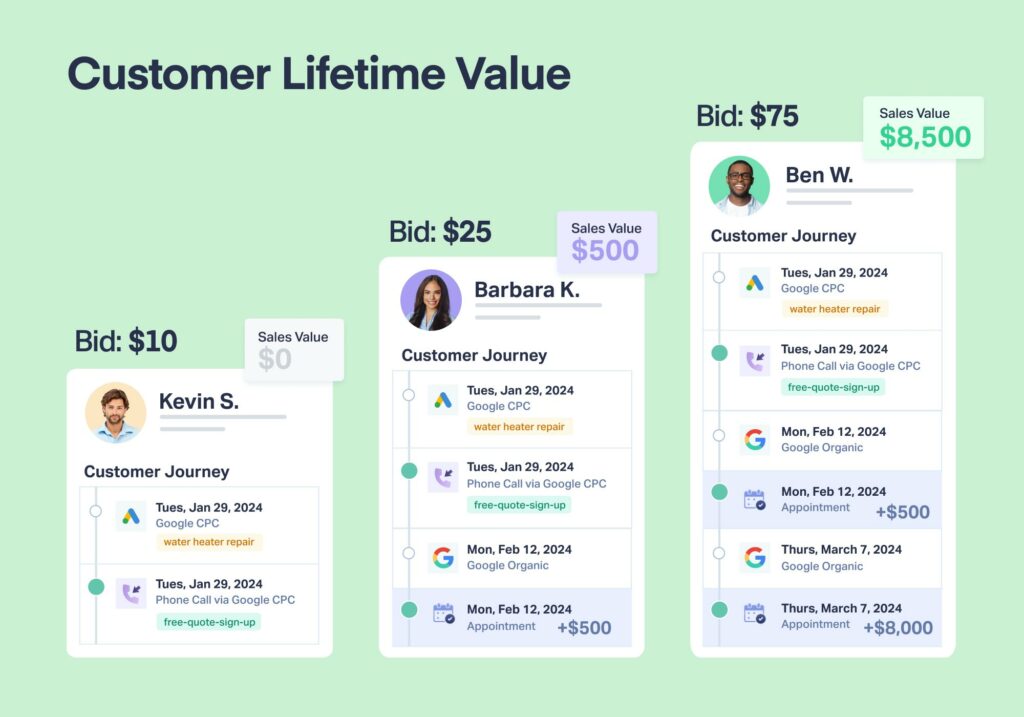
Return customers don’t follow the same rules as new ones.
For them, conversion rates are higher, order values are larger, and the likelihood of referrals is greater. All in all, return customers are more valuable for businesses.
Many lead-gen-reliant business types depend on return customers to keep their doors open. A dentist might bring in first-time leads at a loss because they know patients tend to become repeat customers for life.
There are two ways to account for lifetime customer value with your value based bidding:
- Conversion Value Rules – This tool lets you put value modifiers on a conversion if it meets certain criteria. You can use it to put extra value on leads that show signals of becoming a return customer. So a conversion that also downloads your user guide may get a 10% boost in value.
- Manual Value Increase – You can manually increase the value of a conversion action based on the average lifetime value that you calculate.
To better understand your client’s customer lifetime value, be sure to dig into the customer journey within Lead Details in WhatConverts. Here you can trace every lead back to their very first interaction with your marketing, including every recorded transaction.
5. Follow the Data (Test, Test, Test)
If you do plan on switching to a value based bidding strategy, do your due diligence first.
Always test your strategy shift before making an across-the-board switch.
Run a “clean” experiment on an existing campaign, meaning you’re testing:
- A single variable (bid strategy)
- Same conversion actions
- Even 50/50 split (cookie or traffic) on the control arm and the trial arm
Otherwise you risk results that are confounded by multiple factors.
Follow the detailed guide from Google below for the best results.
Google Ads: Testing Value Based Bidding Using Google Ads Campaign Experiments
Wrapping Up
Moving to a value based bidding strategy in Google Ads can require a bit of work for lead gen businesses and agencies.
But doing so makes it easier to clearly and indisputably prove the ROI of your efforts to clients.
WhatConverts makes value based bidding even more powerful. Start your 14 day trial for free today!
Get a FREE presentation of WhatConverts
One of our marketing experts will give you a full presentation of how WhatConverts can help you grow your business.
Schedule a Demo
Grow your business with WhatConverts





